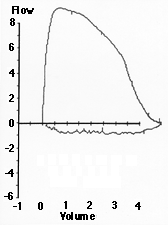Variable Extrathoracic Upper Airway Obstruction

Fixed Upper Airway Obstruction

Interpretation of Pulmonary Function Tests: Spirometry: Interpreting Spirometry
Thomas Gross, MD
Peer Review Status: Externally Peer Reviewed by the Department of Internal Medicine Virtual Hospital Editorial Board
In a variable upper airway obstruction, airflow is compromised by dynamic changes in airway caliber. During normal inspiration, airways within the thorax tend to dilate as the lung inflates while airways outside of the thorax tend to collapse due to the drop in intraluminal pressure. During expiration, the reverse is true as airways within the thorax collapse but airways outside the thorax are held open by expiratory flow.
|
Variable Extrathoracic Upper Airway Obstruction
|
Fixed Upper Airway Obstruction
|
As a result, a variable extrathoracic obstruction primarily affects the inspiratory portion of the flow volume loop, viewed as a flattening of the usual deep inspiratory curve. The expiratory portion of the loop appears relatively normal. Conversely, a variable intrathoracic obstruction mainly affects the expiratory limb, again giving a flattened appearance to that aspect of the loop. This can be difficult to distinguish from the more common small to medium sized airways obstruction that characterizes bronchitis, asthma, and emphysema. Finally, a fixed intrathoracic or extrathoracic obstruction affects both inspiration and expiration, giving a flow volume loop that has an overall box-like shape as both inspiratory and expiratory limbs flatten.
Variable extrathoracic obstructions may be caused by vocal cord paralysis, thyromegaly, tracheomalacia, or neoplasm while large airways variable intrathoracic obstructions can also result from tracheomalacia or neoplasm. Examples of fixed obstruction include tracheal stenosis, foreign body, or neoplasm.
In summary, spirometry is a valuable tool for the assessment of lung disease. By ensuring proper calibration of equipment and performance of test maneuvers, one can differentiate among several different disease processes.